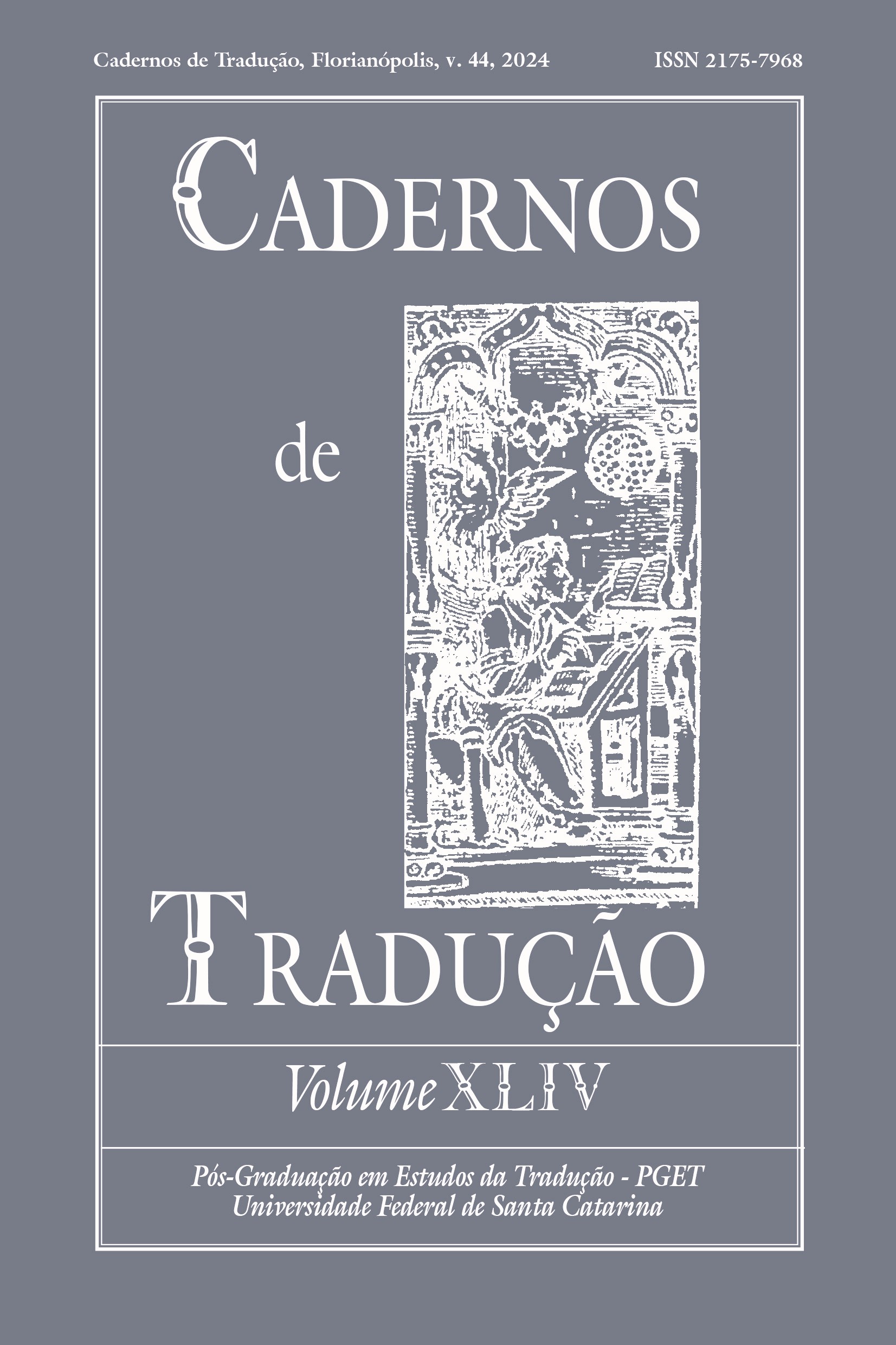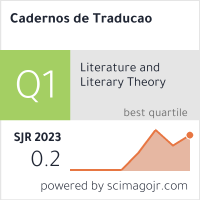National values in the translation of Kazakh literary works
DOI:
https://doi.org/10.5007/2175-7968.2024.e95714Keywords:
translation, language, culture, literary works, functional-semantic meaningAbstract
This article examines the translation of Kazakh cultural objects in literary works, which holds significant importance for Kazakh language and culture. The article analyzes the significance of national hair ornaments and belts in the works of Kazakh writers and their translation into Russian and English. Kazakh people believe that the hair ornament sholpy protects a girl or a young woman from evil forces. This type of hair ornament has both material and spiritual significance in Kazakh culture. In Kazakh literary works, the value of the analyzed jewelry is connected with its affiliation to a person and social status. It is presented as a symbol of female beauty. The belt is a valuable piece of nomadic clothing and a highly valued sacred object in Kazakh culture. Specific functional and semantic meanings as well as translation in literary works have been considered. The importance of translation as a “golden bridge” between different cultures is on the rise. As in other spheres, the requirements for translation are updated depending on the purpose and stage. The anthropocentric trend in modern linguistics raises the question of the relationship between language, man and culture, and poses the task of being able to convey the world view of one nation in the language of another, preserving all cultural and spiritual characteristics, taking into account deep information about people’s background knowledge. The article also analyzes the problem of background knowledge and the peculiarities of translating Kazakh culture-specific elements with spiritual significance for the people. These elements should be taken into account when translating literary works.
References
Auezov, M. (1975). Abai (abridged). Progress.
Auezov, M. (1978). The Path of Abai. Epic-novel in two volumes. Zhazushy.
Auezov, M. (2004). The Path of Abai. Epic-novel. Zhazushy.
Beskemer, A., Kalibekuly, T., Bekbossynova, A. Kh., Satenova, S. K., & Karabayeva, L. K. (2021). Peculiarities and Difficulties of Artistic Translation: A Comparative Analysis of English-Kazakh Literature Works. Astra Salvensis, (1), 365–382.
Casagrande, J. B. (1954). The Ends of Translation. International Journal of American Linguistics, 20(4), 335–340.
Costa, W. C. (2015). Translation Studies and Comparative Literature: Conflict and Complementarity. Cadernos de Tradução, 35(esp. 1), 31–43. https://doi.org/10.5007/2175-7968.2015v35nesp1p31
Daurenbekova, L. N., Zhumatayeva, Z. N., Kartayeva, A. M., Bekenova, G. Sh., & Nurlanova, A. N. (2024). The First Educational Directions and Issues of Literary Translation in the Kazakh Steppe. Cadernos de Tradução, 44(1), 1–12. https://doi.org/10.5007/2175-7968.2024.e95583
de Maupassant, G. (1992). The Necklace and Other Short Stories. Dover Publications.
Doyle, A. C. (2016). Sherlock Holmes. Adventure of the Beryl Coronet. CreateSpace Independent Publishing Platform.
Elikpai, B. (2005). Waist Flexion is a Sign of Strength. Mädeniet Žarşysy, 4, 18–22.
Esenberlin, I. (1978a). The Nomads: The Charmed Sword. Sovetski pisatel.
Esenberlin, I. (1978b). The Nomads: Despair. Sovetski pisatel.
Esenberlin, I. (1978c). The Nomads: Khan Kene. Sovetski pisatel.
Esenberlin, I. (2015a). The Nomads: The Charmed Sword. Association of Publishers, Printers and Booksellers.
Esenberlin, I. (2015b). The Nomads: Despair. Association of Publishers, Printers and Booksellers.
Esenberlin, I. (2015c). The Nomads: Khan Kene. Association of Publishers, Printers and Booksellers.
Esenberlin, I. (2018). Köşpendiler [The Warrior]. Palitra-Press. [in Kazakh]
Gonçalves, D. S. (2015). Translation and Evolution: The Historical Transmission of Culture through Artificial Selection. Cadernos de Tradução, 35(2), 14–40. https://doi.org/10.5007/2175-7968.2015v35n2p14
Issakova, S. S. (2015). Semantic Descriptions of Proverbs and Sayings with the Component Numbers (On the Material of the Kazakh and French Languages). Voprosy Kognitivnoy Lingvistiki, (2), 96–99.
Jakobson, R. (1959). On Linguistic Aspects of Translation. In R. A. Brower (Ed.), On Translation (pp. 232–243). Harvard University Press.
Jüsipbek, A. (2016). Jüsipbek Aymawıtov: Mağjannıñ aqındığı twralı [Aimauytov Zhüsipbek: Magzhannyñ aqyndygy turaly]. Adebi Portal. https://adebiportal.kz/kz/news/view/14658 [in Kazakh]
Kunanbaev, A. (1958). Tañdamalı öleñder [Selected Poems]. Kazgosizdat. [in Kazakh]
Kunanbaev, A. (2017). Öleñder [Poems]. Kazgosizdat. [in Kazakh]
Kuprin, A. (2003). Granatovyy braslet i drugiye istorii [Garnet Bracelet and Other Stories]. Fredonia Books (NL). [in Russian]
Leskov, N. (1957). Zhemchuzhnoye ozherel’ye [The Pearl Necklace]. Khudozhestvennaya Literatura (IHL). [in Russian]
Literary Devices. (2021). Onomatopoeia. Literary Devices. https://literarydevices.com/onomatopoeia/
Maslova, V. A. (2001). Lingvokul’turologiya [Linguoculturology]. Publishing Center “Akademya”. [in Russian]
Musirepov, Ğ. (2006). Ulpan. Raritet. [in Kazakh]
Neves Monteiro, J. C. (2018). Canonical Translation. Cadernos de Tradução, 38(3), 34–49. https://doi.org/10.5007/2175-7968.2018v38n3p34
Newmark, P. A. (1988). Textbook of Translation. Prentice Hall.
Newmark, P. A. (1998). More Paragraphs on Translation. Multilingual Matters.
Nurgaliev, R. N. (Ed.). (1991). Kazakhskaya SSR: kratkaya entsiklopediya [Kazakh SSR: A Brief Encyclopedia]. Kazakh Soviet Encyclopedia. [in Russian]
Oliveira, M. B. (2023). A Solution to the Problem of Radical Translation. Trans/Form/Ação, 9, 9–13. https://doi.org/10.1590/S0101-31731987000100002
Ozhegov, S. I., & Shvedova, N. Y. (2006). Tolkovyy slovar’ russkogo yazyka [Explanatory Dictionary of the Russian Language]. A TEMP. [in Russian]
Petrushka, A., & Mashtalir, V. (2023). Technologies for the Reading Promotion as a Component of the Information Activities. Library Science. Record Studies. Informology, (4), 101–110. http://dx.doi.org/10.32461/2409-9805.4.2023.294082
Pym, A. (2016). Exploring Translations Theories. Translated by E. C. Godarth, Y. N’gana, & B. Sant’Anna. Cadernos de Tradução, 36(3), 214–317. https://doi.org/10.5007/2175-7968.2016v36n3p214
Qulmanov, S. (2015). Awdarmanıñ özekti mäseleleri [Topical Issues of Translation]. Palitra-Press. [in Kazakh]
Raspopova, V. I. (1970). Sogdiyskiy gorod i kochevaya step’ v VII-VIII vv [Sogdian City and Nomadic Steppe in VII-VIII Centuries]. CSIA, 122, 86–91. [in Russian]
Romaniuk, O. (2021). Expression and Interpretation of Attraction and Interpersonal Intimacy: A Comparative Study of Female Nonverbal Behaviour. Analele Universitatii din Craiova – Seria Stiinte Filologice, Lingvistica, 43(1–2), 220–237. https://doi.org/10.52846/aucssflingv.v43i1.18
Romaniuk, O., & Yavorska, L. (2022). Complimenting Behaviour in Young Adults’ First Impression Scripts. Analele Universitatii din Craiova – Seria Stiinte Filologice, Lingvistica, 44(1–2), 168–187. https://doi.org/10.52846/aucssflingv.v44i1-2.58
Shapauov, A., Zhusupov, N., Baratova, M., Bakhytzhan, K., Zhanar, T., Aiman, A., Meyramgul, Z., & Agaliyeva, N. (2014). Dramatic Effect, Style and Speech of Characters of Literary and Art Piece (From Epos to Drama). Life Science Journal, 11(spec. 4), 311–315.
Shaposhnikova, T. D. (Ed.). (2013). Osnovy dukhovno-nravstvennoy kul’tury narodov Rossii [Bases of the Spiritual and Moral Culture of the Peoples of Russia]. Drofa. [in Russian]
Shoibekov, R. N. (2006). Qazaq tiliniñ qolöner leksïkası [Handicraft Vocabulary of the Kazakh Language]. Kazakh Ablai Khan University. [in Kazakh]
Smanova, A. S. (2013). Qazaqtıñ ulttıq kïiminiñ dïzayn erekşelikteri men damw kezeñderin sïpattaw [Description of the Design Features and Stages of Development of the Kazakh National Dress]. Bulletin “Series of Young Scientists”, 1, 121. [in Kazakh]
Temirgazina, Z. K., & Ibraeva, Z. B. (2021). An Observer in Poetic Narrative (In the Poems of Pavel Vasiliev). Vestnik Tomskogo Gosudarstvennogo Universiteta, Filologiya, (72), 290–307. http://dx.doi.org/10.17223/19986645/72/16
Tohtabaeva, Sh. Zh. (2011). Qazaqtıñ zergerlik öneri [Kazakh Jewelry Art]. Kitap. [in Kazakh]
Tolkien, J. R. R. (2012). The Lord of the Rings. Mariner Books.
Toporov, V. I. (1982). Primitivnyye predstavleniya o mire (obshchiy vid) [Primitive Ideas about the World (General View)]. Moscow State Linguistic University. [in Russian]
von Humboldt, V. (1985). Language and Philosophy of Culture. Progress.
Ziak, P., Sakhipzhamal, U., Zeinesh, M., Tanzharikova, A., & Kulgildinova, T. (2022). The Image of the Lifeworld in Philosophy and Fiction Narratives. XLinguae, 15(1), 194–201. https://doi.org/10.18355/XL.2022.15.01.019
Downloads
Published
How to Cite
Issue
Section
License
Copyright (c) 2024 Cadernos de Tradução

This work is licensed under a Creative Commons Attribution 4.0 International License.
Copyright Notice
Authors hold the copyright and grant the journal the right for their articles' first publication, being their works simultaneously licensed under the Creative Commons Attribution License (CC BY), which allows the sharing of such works with its authorship acknowledged and its initial publication in this journal.
Authors are allowed to enter into separate additional contractual arrangements for the non-exclusive distribution of the journal's published version of the work (e.g., post it to an institutional repository or as a book chapter, with an acknowledgment of its initial publication in this journal).










































